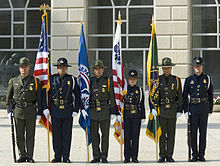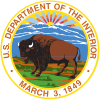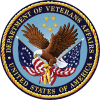Federal law enforcement in the United States
| Law enforcement in the United States |
|---|
|
| Separation of powers |
|
| Jurisdiction |
| Legal context |
|
| Prosecution |
| Lists of law enforcement agencies |
| Police operations/organization/issues |
|
| Types of agency |
|
| Variants of law enforcement officers |
|
| See also |
|
|
The federal government of the United States empowers a wide range of law enforcement agencies to maintain law and public order related to matters affecting the country as a whole.[1][2]
Overview[]
While the majority of federal law enforcement employees work for the departments of Justice and Homeland Security, there are dozens of other federal law enforcement agencies under the other executive departments, as well as under the legislative and judicial branches of the federal government.
Different federal law enforcement authorities have authority under different parts of the United States Code (U.S.C.). Most are limited by the U.S. Code to investigating matters that are explicitly within the power of the federal government. There are exceptions, with some agencies and officials enforcing codes of U.S. states and tribes of Native Americans in the United States. Some federal investigative powers have become broader in practice, especially since the passage of the USA PATRIOT Act in October 2001.[3]
The United States Department of Justice was formerly the largest, and is still the most prominent, collection of federal law enforcement agencies. It has handled most law enforcement duties at the federal level[4] and includes the United States Marshals Service (USMS), the Federal Bureau of Investigation (FBI), the Drug Enforcement Administration (DEA), the Bureau of Alcohol, Tobacco, Firearms and Explosives (ATF), Federal Bureau of Prisons (BOP), and others.
However, the United States Department of Homeland Security (DHS) became the department with the most sworn armed Federal law enforcement officers and agents upon its creation in 2002 in response to the September 11, 2001 terrorist attacks when it incorporated agencies seen as having roles in protecting the country against terrorism. This included large agencies such as U.S. Immigration and Customs Enforcement Homeland Security Investigations (HSI), the U.S. Secret Service (USSS), the U.S. Coast Guard (USCG), the Transportation Security Administration (TSA), and the U.S. Customs and Border Protection (CBP) (created by combining the former agencies of the United States Border Patrol, United States Customs Service, and the United States Department of Agriculture's Animal and Plant Health Inspection Service (APHIS) into a single agency within the DHS).[2]
History[]

Federal law enforcement in the United States is more than two hundred years old. For example, the Postal Inspection Service can trace its origins back to 1772,[5] while the U.S. Marshals Service dates to 1789.[6]
Other agencies, such as the FBI are relatively recent, being founded in the early twentieth century. Other agencies have been reformed, such as the ATF which was started only in 1972, but had its origins in 1886.[7]
List of agencies and units of agencies[]
Agencies in bold text are law enforcement agencies (LEAs).
Executive Branch[]
Department of Agriculture[]

- Office of the Secretary of Agriculture
- Protective Operations Division (POD)[8]
- Office of Inspector General (USDA-OIG)
- United States Forest Service (USFS)
- U.S. Forest Service Law Enforcement & Investigations (USFS LEI)
Department of Commerce[]

- Office of Inspector General (DOC-OIG)
- Office of Security (DOC OS)

- US Commerce Department Police
- National Institute of Standards and Technology (NIST)
- National Institute of Standards and Technology Police
- National Oceanic and Atmospheric Administration (NOAA)
- National Marine Fisheries Service (NMFS)
- Office of Law Enforcement (OLE)
- National Marine Fisheries Service (NMFS)
Department of Defense[]

- Office of Inspector General (DOD-OIG)
- Pentagon Force Protection Agency (PFPA)
- United States Pentagon Police (USPPD)
- Department of Defense Police (DOD Police) ("DOD Police" refers to any civilian engaged in police duties for the DOD and the US Armed Forces).
- Defense Logistics Agency (DLA)
- Defense Logistics Agency Police
- National Security Agency (NSA)
- National Security Agency Police
- Defense Intelligence Agency (DIA)
- Defense Intelligence Agency Police
- National Geospatial-Intelligence Agency (NGA)
- National Geospatial-Intelligence Agency Police
- Department of the Army
- United States Army Criminal Investigation Division (USACID)
- United States Army Counterintelligence (ACI)
- United States Army Military Police Corps (USAMPC)
- Department of the Army Civilian Police (DACP)
- includes Department of the Army Civilian Guards (DASG).
- United States Army Corrections Command (USACC
- Department of the Navy
- Naval Criminal Investigative Service (NCIS)
- United States Marine Corps Criminal Investigation Division (USMC CID)
- Master-at-arms (military police)
- Department of the Navy Police (civilian police)
- Marine Corps Provost Marshal's Office (military police)
- United States Marine Corps Civilian Police (civilian police)
- Department of the Air Force
- United States Air Force Office of Special Investigations (AFOSI)
- Air Force Security Forces Center (AFSFC)
- United States Air Force Security Forces (military police)
- Department of the Air Force Police (civilian police)
- includes Department of Air Force Civilian Guards (DAF Guard)
Department of Education[]

- Office of Inspector General (ED-OIG)
- Protective Service Division (ED-PSD )
- Office for Civil Rights (OCR)
Department of Energy[]

- Office of Inspector General (DOE-OIG)
- Office of Health, Safety and Security (DOE-HSS)
- National Nuclear Security Administration (NNSA)
Department of Health and Human Services[]

- Office of Inspector General (HHS-OIG)
- United States Food and Drug Administration (HHSFDA)
- National Institutes of Health (NIH)
Department of Homeland Security[]


- Office of Inspector General (DHS-OIG)
- Federal Protective Service (FPS)
- Federal Law Enforcement Training Centers (FLETC)
- Office of the Chief Security Officer (OCSO)
- United States Coast Guard (USCG)
- United States Customs and Border Protection (CBP)
- United States Border Patrol (USBP)
- CBP Air and Marine Operations (AMO)
- CBP Office of Field Operations (OFO)
- Federal Emergency Management Agency (FEMA)
- Mount Weather Emergency Operations Center
- Mount Weather Emergency Operations Center Police
- Office of Chief Security Officer (OCSO)
- Mount Weather Emergency Operations Center
- United States Immigration and Customs Enforcement (ICE)
- Homeland Security Investigations (HSI)
- Enforcement Removal Operations (ERO)
- Office of Intelligence
- Office of Professional Responsibility (OPR)
- United States Secret Service (USSS)
- Transportation Security Administration (TSA)
- Office of Law Enforcement (OLE)/Federal Air Marshal Service (FAMS)
- Federal Flight Deck Officer (FFDO)
- Office of Inspection (OI)
- United States Citizenship and Immigration Services (USCIS)
- Fraud Detection and National Security Directorate (FDNS)
Department of Housing and Urban Development[]

- Office of Inspector General (HUD-OIG)
- Protective Service Division (HUD-PSD)
Department of the Interior[]

- Office of Inspector General (DOI-OIG)
- Bureau of Indian Affairs (BIA)
- Office of Justice Services
- Bureau of Land Management (BLM)
- Office of Law Enforcement
- United States Bureau of Reclamation (BOR)
- Office of Law Enforcement
- National Park Service (NPS)
- Office of Surface Mining Reclamation and Enforcement (OSMRE)
- United States Fish and Wildlife Service (USFWS)
- Office of Law Enforcement (FWS OLE)
- Division of Refuge Law Enforcement
Department of Justice[]

- Office of the Inspector General (DOJ-OIG)
- Bureau of Alcohol, Tobacco, Firearms and Explosives (ATF)
- Drug Enforcement Administration (DEA)
- Federal Bureau of Investigation (FBI)
- Federal Bureau of Prisons (BOP)
- United States Marshals Service (USMS)
- Office of Professional Responsibility (DOJ OPR)

Department of Labor[]

- Office of Inspector General (DOL-OIG)
Department of State[]

- Office of Inspector General (DOS-OIG)
- Bureau of Diplomatic Security (DS)
- Diplomatic Security Service (DSS)
Department of Transportation[]

- Office of Inspector General (DOT-OIG)
- United States Merchant Marine Academy
- Department of Public Safety (USMMADPS)
- National Highway Traffic Safety Administration
- Office of Odometer Fraud Investigation (OFI)
Department of the Treasury[]


- Office of Inspector General (USDT-OIG)
- Bureau of Engraving and Printing
- Bureau of Engraving and Printing Police
- Financial Crimes Enforcement Network (FINCEN)
- Internal Revenue Service (IRS)
- Criminal Investigation (IRS-CI)
- United States Mint Police (USMP)
- Treasury Inspector General for Tax Administration (TIGTA)
- Special Inspector General for Pandemic Recovery (SIGPR)[9]
- Special Inspector General for the Troubled Asset Relief Program (SIGTARP)

Department of Veterans Affairs[]

- Office of Inspector General (VA-OIG)
- Veterans Affairs Police
Legislative Branch[]

- Sergeant at Arms of the United States House of Representatives
- Sergeant at Arms of the United States Senate
- United States Capitol Police (USCP)
- Office of Inspector General (USCP OIG)
- Office of Professional Responsibility (USCP OPR)
- Library of Congress (LOC)
- Office of Inspector General (LOC-OIG)
- Government Publishing Office (GPO)
- Office of Inspector General (GPO-OIG)
- Government Publishing Office Police
Judicial Branch[]
- Marshal of the United States Supreme Court
- Administrative Office of the United States Courts (AOUSC)
- Office of Probation and Pretrial Services (Federal Probation Officers)
Other federal law enforcement agencies[]
Independent Agencies and federally-administered institutions;
- Central Intelligence Agency
- Security Protective Service (CIA SPS)
- United States Environmental Protection Agency
- Office of Inspector General (EPA-OIG)
- Office of Enforcement and Compliance Assurance (OECA)
- Criminal Investigation Division
- National Gallery of Art
- Office of Protection Services
- NASA
- Office of Inspector General (NASA-OIG)
- Office of Protective Services (NASA OPS)
- United States Office of Personnel Management (OPM)
- Office of Inspector General (OPM OIG)

- United States Postal Service (USPS)
- Office of Inspector General (USPS-OIG)
- United States Postal Inspection Service (USPIS)
- U.S. Postal Police
- Smithsonian Institution (SI)
- Office of Inspector General (SI-OIG)
- Office of Protection Services
- National Zoological Park Police (NZPP)
- Amtrak
- Office of Inspector General (Amtrak-OIG)
- Office of Security Strategy and Special Operations (OSSSO)
- Amtrak Police Department
- Federal Reserve System
- Office of Inspector General (FRB/CFPB-OIG)
- Federal Reserve Police
- Federal Reserve Board of Governors
- Federal Reserve Board Police
- Tennessee Valley Authority
- Office of Inspector General (TVA-OIG)
- Tennessee Valley Authority Police (TVAP)
- Nuclear Regulatory Commission (NRC)
- Office of Inspector General (NRC-OIG)
- National Science Foundation (NSF)
- Office of Inspector General (NSF-OIG)
- National Archives and Records Administration (NARA)
- Office of Inspector General (NARA-OIG)
- Peace Corps (PC)
- Office of Inspector General (PC-OIG)
- Railroad Retirement Board (RRB)
- Office of Inspector General (RRB-OIG)
- Small Business Administration (SBA)
- Office of Inspector General (SBA-OIG)
- Federal Deposit Insurance Corporation (FDIC)
- Office of Inspector General (FDIC-OIG)
- General Services Administration (GSA)
- Office of Inspector General (GSA-OIG)
- Social Security Administration (SSA)
- Office of Inspector General (SSA-OIG)
- United States Agency for International Development
- Office of Inspector General (AID-OIG)
- Corporation for National and Community Service (CNCS)
- Office of Inspector General (CNCS-OIG)
List of former agencies and units of agencies[]
- Bureau of Internal Revenue, Narcotic Division (1921-1927) (transferred to Bureau of Prohibition)
- Bureau of Prohibition, Narcotic Division (1927-1930) (merged into Federal Bureau of Narcotics)
- Federal Narcotics Control Board (FNCB) (1922-1930) (merged into Federal Bureau of Narcotics)
- White House Police Force (1922-1930) (became part of the United States Secret Service. It was renamed the Executive Protective Service in 1970 and then the Uniformed Division of the Secret Service in 1977)
- Steamboat Inspection Service (1871-1932) (merged into Bureau of Marine Inspection and Navigation)
- Bureau of Marine Inspection and Navigation (1884-1946) (functions split between U.S. Customs Service and U.S. Coast Guard)
- Federal Bureau of Narcotics (FBN) (1930-1968) (merged into Bureau of Narcotics and Dangerous Drugs)
- Bureau of Drug Abuse Control (1966-1968) (merged into Bureau of Narcotics and Dangerous Drugs)
- Bureau of Narcotics and Dangerous Drugs (BNDD) (1968-1973) (merged into Drug Enforcement Administration)
- Office of Drug Abuse Law Enforcement (ODALE) (1972-1973) (merged into Drug Enforcement Administration)
- Office of National Narcotics Intelligence (ONNI) (1972-1973) (merged into Drug Enforcement Administration)
- Bureau of Secret Intelligence (BSI) (1916-1985) (replaced by Diplomatic Security Service)
- United States Treasury Police (TPF) (1879-1986) (merged with the Uniformed Division of the Secret Service)
- United States Customs Service (1789-2003) (functions split between U.S. Customs and Border Protection and U.S. Immigration and Customs Enforcement)
- Immigration and Naturalization Service (INS) (1940-2003) (functions transferred to three new entities – U.S. Citizenship and Immigration Services, U.S. Immigration and Customs Enforcement, and U.S. Customs and Border Protection.)
- Library of Congress Police (LCP) (1950-2009) (merged into the United States Capitol Police)
- Hoover Dam Police (1931-2017) Merged with the Department of Interior
- Federal Investigative Services Division (replaced by National Background Investigations Bureau in 2016)
- National Background Investigations Bureau (2016-2019) (merged with Defense Counterintelligence and Security Agency)
- Defense Investigative Service (DSS) (1972-1999) (changed to Defense Security Service)
- Defense Security Service (DSS) (1999-2019) (merged with Defense Counterintelligence and Security Agency)
Statistics[]
- In 2004, federal agencies employed approximately 105,000 full-time personnel authorized to make arrests and carry firearms in the 50 states and the District of Columbia. Compared with 2002, employment of such personnel increased by 13%.
- Nationwide, there were 36 federal officers per 100,000 residents. Outside the District of Columbia, which had 1,662 per 100,000, State ratios ranged from 90 per 100,000 in Arizona to 7 per 100,000 in Iowa.
- As of 2004, about 3 in 4 federal law enforcement officers working outside the Armed Forces were employed within the Department of Homeland Security or the Department of Justice.
- Federal officers' duties included criminal investigation (38%), police response and patrol (21%), corrections and detention (16%), inspections (16%), court operations (5%), and security and protection (4%).
- Women accounted for 16% of federal officers in 2004, an increase from 14.8% in 2002.
- A third (33.2%) of federal officers were members of a racial or ethnic minority in 2004. This included 17.7% who were Hispanic or Latino, and 11.4% who were black or African American. In 2002, racial or ethnic minorities officers comprised 32.4% of federal officers.
- Twenty-seven federal offices of inspector general (IG) employed criminal investigators with arrest and firearm authority in 2004. Overall, these agencies employed 2,867 such officers in the 50 states and District of Columbia.[1]
See also[]
- Law enforcement in the United States
- List of United States state and local law enforcement agencies
- Office of Inspector General (United States)
References[]
- ^ a b bjs.ojp.usdoj.gov Archived 2013-02-15 at the Wayback Machine Federal Law Enforcement United States Bureau of Justice Statistics Publications & Products. Page last revised on 17 June 2010. Retrieved 2010-06-17.
- ^ a b "CBP Through the Years - U.S. Customs and Border Protection".
- ^ Hatcher, Jeanette. "LibGuides: Criminal Justice: Federal Law Enforcement Agencies".
- ^ Langeluttig, Albert (1927). The Department of Justice of the United States. Johns Hopkins Press. pp. 9–14.
- ^ "History of the United States Postal Inspection Service". Retrieved 2020-02-06.
- ^ "U.S. Marshals Service".
- ^ "Bureau of Alcohol, Tobacco, Firearms and Explosives".
- ^ "Protective Operations Division".
- ^ https://crsreports.congress.gov/product/pdf/IN/IN11328
 This article incorporates public domain material from websites or documents of the United States Government.
This article incorporates public domain material from websites or documents of the United States Government.
External links[]
| Wikimedia Commons has media related to Federal police of the United States. |
- Federal law enforcement in the United States
- Federal law enforcement agencies of the United States
- Lists of government agencies in the United States
- Lists of law enforcement agencies